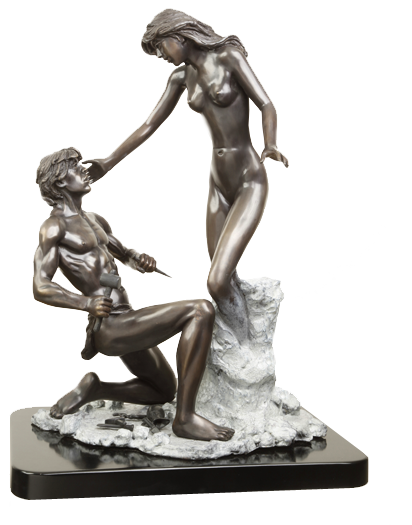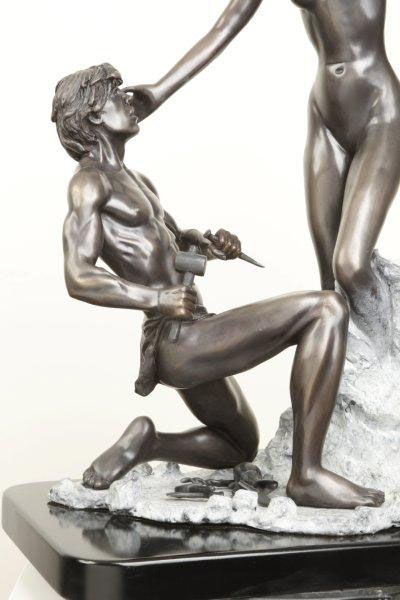 home
about
artists
exhibitions
press
contact
purchase
home
about
artists
exhibitions
press
contact
purchase |
|||||
|
RICHARD L. MINNS Medium-size table top bronze. Classic potash rich dark brown patination on Pygmalion and Galatea. Black patination on Pygmalion’s sculptor’s tools. Special grey/white marble patination on ground and marble part of Galatea’s statue. 79 cm high x 54 cm long x 37cm wide, 31 in high x 21 in long x 15 in wide. CLASSICAL MYTHOLOGY As written in Ovid’s Metamorphosis, Pygmalion was a very handsome and very famous young sculptor in ancient Cyprus who wanted to marry and raise a family, but he could not find a woman who measured up to his standard of perfection. Therefore, he summoned all of his great skills and created the perfect woman out of a block of marble, then falling hopelessly in love with his creation. Pygmalion prayed to Aphrodite (Venus), the goddess of love, who gave the marble statue the gift of life. Pygmalion took his creation in his arms and since her fair skin was as white as milk, he named her Galatea, after the Greek word for milk. They had a son, Paphos, and the Cyprus city of Paphos bears his name to this day, preserving the story for all eternity. DESCRIPTION OF SCULPTURE The basic Pygmalion story has made its influence in literary / art / musical history more than any other Greek myth as each generation of artists, sculptors, writers, poets, playwrights, composers and musicians continue the Pygmalion concept in art, sculpture, literature, theatre, opera and cinema. First to come to mind is George Bernard Shaw’s award-winning play “Pygmalion”, which was turned into the award-winning stage and screen musical “My Fair Lady”, starring Rex Harrison as “Professor Higgins” and Audrey Hepburn as “Eliza Doolittle”. The seemingly endless list of branches from the Pygmalion tree includes “Phantom of the Opera”, “Educating Rita”, Nathaniel Hawthorne’s “The Birth-Mark”, Oscar Wilde’s “The Picture of Dorian Gray”, “Pinocchio”, even Mary Shelley’s “Frankenstein” and even the Simpsons’ episode entitled “Pygmoelian”. Artists and sculptors who have given their interpretation of Pygmalion include Auguste Rodin, Francisco Goya, Honoré Daumier, Edward Burne-Jones, Paul Delvaux, among countless others. Richard now enters the classical ring with his interpretation. Richard’s Pygmalion, his sculptor’s chisel in one hand and hammer in the other, is kneeling before his marble creation of Galatea, making the final touches. He hears a movement and laughter above him and looks up to see to his surprise and delight that Venus (Aphrodite) has granted his prayers and his creation has come to life. Galatea, laughing, reaches out to her lover, touching his cheek. To effectively portray this metamorphosis, Galatea’s upper half (the part which has come alive) is in bronze (like Pygmalion), where the lower part of her legs is still in marble. To create contrast and drama, the ground is white marble, which stands out on the ivory black polished base. Pygmalion’s sculpture tools are scattered on the white marble ground. The tools are covered with a black patina, in stark contrast to the white ground. Pygmalion and the part of Galatea which has come alive has a classic potash rich dark brown patination to effectively portray Galatea’s metamorphosis. Now the beauty of this magnificent bronze and marble sculpture is that the sculpture is 100% bronze and there is no marble on it. The white marble block, which Galatea is breaking out of, and the white marble floor is not real marble. Richard can create a bronze sculpture which looks identical to marble. This is the beauty of having a patination master and Richard’s foundry has one of the best in the world. ARTIST’S INTERPRETATION “I am an ex-Journalism professor and a frustrated “Story Teller”. I get great pleasure writing stories and reading them, first to my children (now grown), then to my grandchildren (now grown), and presently to my great grandchildren.” “The purpose of my sculptures is to tell a story. If my sculpture needs to be explained to the viewer, then I have failed. My sculpture stories are about the heroes of the Bible and the heroes of classical mythology. (Of course, it helps if the viewer knows the story.)” “My interpretation of Pygmalion is a young, handsome sculptor with a pleasing trim athletic body, but certainly not a Hercules, Samson or an Achilles. Galatea is the perfect woman – or at least Pygmalion’s concept of the perfect woman for him. Slim, feminine, with large eyes and Angelina Jolie lips.” “By casting the entire sculpture in bronze and relying on my patination expert to simulate marble, I was able to show a mixture of classic potash and white patina slowly blending together on Galatea’s legs. Look close. I think you will like it.” “I could say more, but I will let me sculpture speak for me. If you feel I have effectively told the Pygmalion story, then I have succeeded.”Richard L. Minns
|
|||||
|
|
|||||




